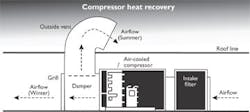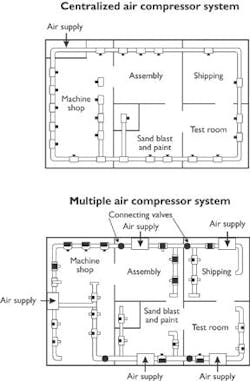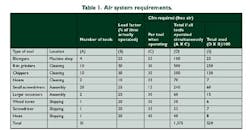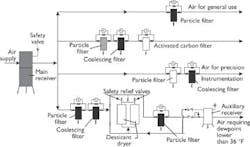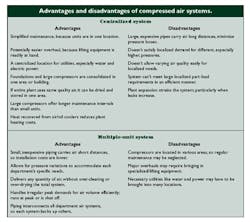Plant engineers know the importance of compressed air in the industrial environment. Because it's as vital as electricity, gas and water to plant operation, compressed air is often regarded as a "fourth utility." But unlike the other three, which are purchased from outside sources, a plant's compressed air supply is generated on-site, using its own equipment. That's why every industrial plant, whatever its size, needs a dependable, efficient plant air system. Selecting the right one requires a careful, informed approach, guided by the principles of common sense engineering and design simplicity.
While the primary responsibility for specifying a new or expanded compressed air system usually rests with the plant engineer, others may be involved in the decision-making process. A specifier has two options: a plant-wide centralized compressed air system or a distributed system using multiple localized compressors (see Figure 1).
Figure 1. Heat from a compressor can be recovered and used for space heating, thus reducing utility costs.
Reliability and efficiency
To determine the most suitable option, evaluate two factors to optimize plant operations. First, determine specific demands and work toward achieving an air system with long-term dependable performance. The second factor is system efficiency, analyzed from two perspectives: the generation and distribution of compressed air, and the processes or machines that require that air.
As you begin the process of choosing between a centralized and a multi-compressor system, answer the following questions:
- Is this a new plant or an expansion of an existing installation?
- What is the system's overall size and scope?
- What are the critical air needs of selected users?
- What are the overall system demands?
New system versus expansion
Although designing an air supply for a new facility is a large task, it's often easier than expanding an existing one. New installations offer almost complete control over design variables. The system can be optimized without making concessions for the existing air supply and its downstream components, such as piping, filters, dryers and lubricators.
In an expansion, new users are added to a system designed for other purposes, and accommodating new operations may compromise the original system. However, you can either expand the existing plant system or install a larger dedicated compressor.
Expanding an existing multi-compressor system requires balancing costs and the efficiency and cost of a central system. In some cases, the efficiency and reliability of a dedicated compressor may be the best choice.
Keep the initial cost of centralized and multiple systems in perspective. Annual operating costs for either option probably will exceed the first cost by a factor of three to four. For this reason, system efficiency should receive higher priority than initial cost.
System size and scope
Start with the basics, such as deciding whether the system is to serve one building or multiple buildings within a complex. Many single-building applications may be larger than a multi-building application in terms of piping length, system demands and general air requirements.
The multi-building system offers unique challenges, such as distribution and distance. Distance may make a centralized system impractical. On the other hand, overall air demand, including pressure and volume, may require a centralized approach.
Distribution and distances between compressors and individual users dictate piping size and downstream air quality. Balance installation, maintenance and operating costs with reliability and efficiency requirements. If they are not properly sized and insulated, external pipe runs to remote buildings will result in pressure loss and condensation.
Utilities
Examine the availability and cost of electricity, water and sewers. Check load factors and rate schedules. For example, a central compressor may require a costly electrical service upgrade, possibly a new substation. Smaller, multiple compressors may be able to operate from the existing electrical service, but will consume more electricity.
Heat recovery
Compressor heat recovery (see Figure 2) is a common technique for increasing overall efficiency. In air-cooled systems, the low-grade heat that's recovered can be used for space heating, thereby reducing purchased utility costs. However, consider the installation and operating costs associated with heat recovery equipment.
Figure 2. Piping layouts are similar for multiple and centralized systems. Connecting valves allow multiple systems to back up each other.
Heat recovery from water-cooled compressors has become increasingly popular. A closed-loop cooling system reduces utility costs because it slashes water and sewer use. Consider these utilities carefully, because availability may be limited in areas unprepared for industrial-size loads. In many industrial areas, sewer charges far exceed water charges. In some areas, they are triple the cost of water.
Location and access
Easy access to equipment for maintenance and replacement is a requisite for both central and multi-compressor systems. When compressors are located in remote outdoor enclosures, physical access is often a challenge. If a compressor is walled off, provide adequate ventilation to cool the unit and to meet air intake needs.
Physical access can affect system reliability. The location of a liquid or air-cooled heat exchanger is important. A closed-loop liquid or air-to-air heat recovery system should be accessible for service. When considering where to place the compressor, make allowances for emergency air service from a portable truck, or think about a skid-mounted compressor.
Avoid degrading heat exchanger performance by siting the compressor in high ambient temperatures, direct sunlight or extreme seasonal fluctuations. Placing a large radiator-type oil cooler outdoors, for example, can lead to startup problems in cold weather.
Meet critical needs
Examine every application in the plant to identify situations where a reliable air supply is critical to safety, production, raw material conservation or equipment safeguards. Include air requirements for overall demand schedules, pressure, volume and air quality.
A critical need doesn't necessarily require its own compressor. In a centralized system, valving and interconnecting piping can meet most critical pressure and volume needs. However, you may want to consider a single, dedicated compressor for standby use.
Meeting system demand
Next, review the facility's overall air requirements. Include base load and base requirements, as well as critical needs in the system demand. Define the system's operating load. For example, identify whether the load's volume and pressure are relatively constant or whether they're subject to fluctuations. If they fluctuate, identify the causes. Specific non-critical applications can cause swings in operating pressure or volume. Large-load fluctuations in industrial systems are often caused by the following factors:
- Uneven demand from shift to shift.
- Waves of demand within a shift, for example, when machines are idling during scheduled work breaks.
- A single process or machine with a large, brief air requirement.
- Consider rescheduling applications to eliminate the need for a central or satellite compressor.
Central systems usually involve several large compressors at a single location in the plant. In this arrangement, a primary compressor is kept online to meet base load, while a running, unloaded standby compressor meets fluctuating demand. Reserve capacity provides a built-in safety factor in case of primary compressor failure. If properly sized, the secondary compressor permits primary unit maintenance with no interruption in air supply.
A multi-compressor system can, with proper controls and interconnecting hardware, perform as a centralized system to handle a variety of load fluctuations.
Controls are a major consideration for centralized systems. Multi-unit or "lead-lag" controls bring compressors online as needed. Internal capacity controls reduce compressor output to meet system needs. Reciprocating compressors use suction valve unloading devices, while rotary-screw compressors modulate capacity through suction throttling, variable displacement, load/unload and variable speed drives.
Air pressure
Volume and pressure demands can't be separated. Pressure, volume and frequency demands on a system are expressed as total air requirement. The sum of the normal air consumption by each user is a number typically found by using the load factor concept.
The work factor approach helps to avoid sizing a system or individual compressor for a single maximum pressure or volume requirement. It involves two variablesthe percent of time the user consumes compressed air and the work factor, which is the air flow rate needed to achieve a user's maximum work output. For most tools, average air consumption can replace the work factor (see Table 1).
Air quality
End use dictates air quality, but users that require high-quality air shouldn't drive overall system design. Air quality isn't necessarily a function of compressor type; the location of the air intake may be more critical.
Minimize initial compressor cost by determining each user's air quality needs up front. For users that require specific air quality, filtration and other purifying equipment in a centralized system may be satisfactory. For example, a user that requires oil-free air can be supplied by a discrete compressor or by purifying central air at the point of use. If dirt is the issue, don't control purity for the entire system; use local filtration and remove condensate at the point of use (see Figure 3).
Figure 3. Typical air systems arrangement shows various combinations of dryers and filters needed to supply the requirements of each subsystem.
When a multi-compressor system means multiple locations, having to discharge and handle oil and water condensate can be inconvenient and costly. If centralized system piping is routed outdoors, pay attention to ambient air temperatures and dew points. Extreme temperature variations can result in greater condensation, which can overwhelm air drying capacity.
There is no single "right" answer to supplying a facility with compressed air. Each situation must be evaluated and specified individually. However, two principles should guide planning: common sense engineering, which affects system reliability, and design simplicity, which enhances system efficiency.

